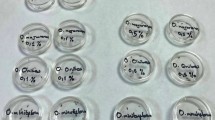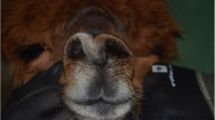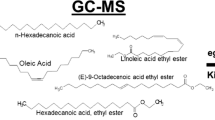Abstract
Nasopharyngeal myiasis is an important high incidence disease among camels in the Middle East and North of Africa caused by Cephalopina titillator (C. titillator) that results in sever economic losses in many camel breeding areas around the world. The current study was conducted to evaluate the efficacy of three essential oils; camphor, ginger and cinnamon oils and their histopathological effects on the 3rd larval instar of C. titillator, with special regard to the prevalence percentage of C. titillator infestation in slaughtered camels at Egyptian abattoirs in addition to investigate histopathological alterations of the infested animal’s tissue. This study fulfilled that the prevalence of C. titillator infestation was 35.2% among slaughtered camels during summer season. The three tested essential oils were caused a significant mortality of C. tittilator; however, camphor oil was exhibited greater and quicker insecticidal effect than ginger and cinnamon oils at the same concentration in terms of mortality of the 3rd instar C. tittilator larvae. There was a concentration-dependent effect on the larvae among the tested essential oils. The tested essential oils were caused remarkable histopathological alterations on the treated larval cuticle. The main salient lesions of the examined infested camel’s tissue were necrotic and inflammatory alterations associated with cystic dilation of submucosal glands.



Similar content being viewed by others
References
Abd El-Rahman S (2010) Prevalence and pathology of nasal myiasis in camels slaughtered in El-Zawia Province-Western Libya: with a reference to thyroid alteration and renal lipidosis. Glob Vet 4(2):190–197
Abdel-Shafy S, El-Khateeb RM, Soliman MM, Abdel-Aziz MM (2009) The efficacy of some wild medicinal plant extracts on the survival and development of third instar larvae of Chrysomyia albiceps (Weid) (Diptera: Calliphoridae). Trop Anim Health Prod 41:1741–1753
Abdurrahman A, Osman S, Salih K, Ismet O (2008) Insecticidal activity of the essential oils from different plants against three stored-product insect. J Ins Sci 10(21):1–13
Abu El Ezz NMT, Khalil FAM, Shaapan RM (2011) Therapeutic effect of onion (Allium cepa) and Cinnamon (Cinnamomum zeylanicum) oils on Cryptosporidiosis in experimentally infected mice. Glob Vet 7:179–183
Alahmed AM (2002) Seasonal prevalence of Cephalopina titillator larvae in camels in Riyadh region, Saudi Arabia, Arab Gulf. J Sci Res 20(3):161–164
Al-Ani F, Amr Z (2016) Seasonal prevalence of the larvae of the nasal fly (Cephalopina titillator) in camels in Jordan. Rev Elev Med Vet Pays Trop 69(3):125–127
Al-Ani FK, Khamas WA, Zenad KH (1991) Camel nasal myiasis: clinical epidemiological and pathological studies in Iraq. Ind J Anim Sci 61:576–578
Ashmawy KI, Fahmy MM, Hilali M (1985) Incidence and seasonal variations of the larvae of Cephalopina titillator infesting camels (Camelus dromedarius) in Egypt. In: Proceedings of the 12th symposium, pp 43–44. Scandinavian Society of Parasitology, Tromsy, Norway, 17–19 June, Abo Akademi, Finland
Bancroft JD, Stevens A, Turner DR (1996) Theory and practice of histological techniques, 4th edn. Churchill Livingstone, New York
Barbakadze N (2005) Micro/nanomechanical measurements on insect and plant cuticles. PhD Thesis, Dissertation an der Universität Stuttgart, Bericht, vol 172, p 128
Bedini S, Flamini G, Cosci F, Ascrizzi R, Echeverria MC, Guidi L, Landi M, Lucchi A, Conti B (2017) Artemisia spp. essential oils against the disease-carrying blowfly Calliphora vomitoria. Parasites Vectors 10:80
El Bassiony GM, Al Sagair OA, El Dally ES, El Nady AM (2005) Alterations in the pituitary–thyroid axis in camel (Camelus dromedarius) infected by larvae of nasal bot fly Cephalopina titillator. J Anim Vet Adv 4(3):345–348
Fatani A, Hilali M (1994) Prevalence and monthly variations of the second and third instars of Cephalopina titllator (Diptera: Oestridae) infesting camels (Camelus dromedarius) in the Eastern Province of Saudi Arabia. Vet Parasit 53(1/2):145–151
Hall MJR, Wall R (1995) Myiasis of humans and domestic animals. Adv Parasitol 35:257–334
Hayes JW, Smith JW (1994) Diflubenzuron plus cottonseed oil: effects on boll weevil (Coleoptera: Curculionidae) cuticle hardness, mating and flight. J Econ Entomol 87:339–344
Higgins AJ (1985) The camel in health and disease. 4. Common ectoparasites of the camel and their control. Br Vet J 141:197–216
Hurst H (1940) Permeability of insect cuticle. Nature 145:462–463
Hussein MF, Hassan HAR, Bilal HK, Basmae’il SM, Younis TM, Al-Motlaq AAR, Al-Sheikh MA (1983) Cephalopina titillator infection in Saudi Arabian camels. J Vet Med 30:553–558
Khater HF (2013) Bioactivity of essential oils as green biopesticides: recent global scenario. In: Govil JN, Bhattacharya S (eds) Essentials oils II. Recent progress in medicinal plants, vol 37. Studium Press, Houston, pp 151–218
Khater HF (2014) Bioactivities of some essential oils against the camel nasal botfly, Cephalopina titillator. Parasitol Res 113(2):593–605
Khater HF, Khater DH (2009) The insecticidal activity of four medicinal plants against the blowfly Lucilia sericata (Diptera: Calliphoridae). Int J Dermatol 48(5):492–497
Khater HF, Ramadan MY, El-Madawy RS (2009) The lousicidal, ovicidal, and repellent efficacy of some essential oils against lice and flies infesting water buffaloes in Egypt. Vet Parasitol 164:257–266
Khater HF, Ramadan MY, Abdel Mageid AD (2013) In vitro control of the camel nasal botfly, Cephalopina titillator, with doramectin, lavender, camphor, and onion oils. Parasitol Res 112(7):2503–2510
Kim HK, Yun YK, Ahn YJ (2008) Fumigant toxicity of cassia bark and cassia and cinnamon oil compounds to Dermatophagoides farinae and Dermatophagoides pteronyssinus (Acari: Pyroglyphidae). Exp Appl Acarol 44(1):1–9
Kumar P, Mishra S, Malik A, Satya S (2013) Housefly (Musca domestica L.) control potential of Cymbopogon citratus Stapf. (Poales: Poaceae) essential oil and monoterpenes (citral and 1,8-cineole). Parasitol Res 112(1):69–76
Litchfield JT, Wilcoxon FA (1949) Simplified method of evaluating dose–effect experiments. J Pharmacol Exper Ther 96:99–113
Morsy TA, Aziz AS, Mazyad SA, Al Sharif KO (1998) Myiasis caused by Cephalopina titillator (Clark) in slaughtered camels in Al Arish abattoir, North Sinai governorate, Egypt. J Egypt Soc Parasitol 28(1):67–73
Musa MT, Harrison M, Ibrahim AM, Taha TO (1989) Observation on Sudanese camel nasal myiasis caused by the larvae of Cephalopina titillator. Rev Elev Med Vet Pays Trop 42(1):27–31
Najar-Rodríguez AJ, Walter GH, Mensah RK (2007) The efficacy of a petroleum spray oil against Aphis gossypii glover on cotton. Part 1: Mortality rates and sources of variation. Pest Manag Sci 63:586–589
Oryan A, Valinezhad A, Moraveji M (2008) Prevalence and pathology of camel nasal myiasis in eastern areas of Iran. Trop Biomed 25(1):30–36
Otranto D (2001) The immunology of myiasis: parasite survival and host defense strategies. Trends Parasitol 17(4):176–182
Rajendran S, Sriranjini V (2008) Plant products as fumigants for stored product insect control. J Stored Prod Res 44(2):126–135
Seddiek SA, Khater HF, El-Shorbagy MM, Ali MM (2013) The acaricidal efficacy of aqueous neem extract and ivermectin against Sarcoptes scabiei var. cuniculi in experimentally infested rabbits. Parasitol Res 112(6):2319–2330
Shakerian A, Hosseini SR, Abbasi A (2011) Prevalence of Cephalopina tittilator (Diptera: Oestridae) larvae in one-humped camel (Camelus dromedarius) In Najaf-Abad, Iran. Glob Vet 6(3):320–323
Stadler T, Buteler M (2009) Modes of entry of petroleum distilled spray-oils into insects: a review. Bull Insectol 62:169–177
Stadler T, Schang MM, Zerba E (1996) Caracterización fisicoquímica y toxicológica de algunos aceites minerales de uso fitosanitario. Rev Invest Agrop 27:67–80
Wigglesworth VB (1941) Oils aiding loss of water from the cuticle. Nature 147:116
Wins-Purdy AH, Whitehouse C, Judd GJR, Evenden ML (2009) Effect of horticultural oil on oviposition behavior and egg survival in the oblique banded leaf roller (Lepidoptera: Tortricidae). Canad Entomol 141:86–94
Zayed AA, Abdel-Meguid A, Madbouly MH, EI-Moursy AA, EL-Khateeb RM (1994) Incidence and monthly prevalence of Cephalopina titillator (Diptera: Oestridae) larvae infesting dromedary camels slaughtered at Egyptian abattoir. J Egypt Vet Med Ass 54:13–22
Zenner L, Callait MP, Granier C, Chauve C (2003) In vitro effect of essential oils from Cinnamomum aromaticum, Citrus limon and Allium sativum on two intestinal flagellates of poultry, Tetratrichomonas gallinarum and Histomonas meleagridis. Parasite 10:153–157
Zumpt F (1965) Myiasis in man and animals in the Old World. A text book for physicians, veterinarians and zoologists. Butterworth’s, London
Author contributions
Nadia M. T. Abu El Ezz: 1. Designed, supervised and provided the steering for the experiment. 2. Collected C. tittilator larvae samples. 3. Performed in vitro treatment of larvae; the insecticidal efficacy of the tested essential oils. 4. Carried out writing and revising the manuscript. Noha M. F. Hassan: 1. Collected C. tittilator larvae samples. 2. Proceeded in vitro treatment of larvae; the insecticidal efficacy of the tested essential oils. 3. Determined prevalence percentage of C. titillator infestation. 4. Recorded light microscopic observations; histopathological effect of the tested oils on 3rd instars C. tittilator larvae. 5. Implemented statistical analysis. 6. Carried outwriting, interpertation and revising the manuscript. Amira H. El Namaky: 1. Collected C. tittilator larvae samples. 2. Continued in vitro treatment of larvae; the insecticidal efficacy of the tested essential oils. 3. Described light microscopic observations; histopathological effect of the tested oils on 3rd instars C. tittilator larvae. 4. Carried out writing and revising the manuscript. Faten A. M. Abo-Aziza: 1. Collected tissue samples. 2. Mentioned light microscopic observations; histopathological alterations of tissues infested by C. C. tittilator larvae. 3. Carried out writing the manuscript. All authors read and approved the final version of the manuscript.
Author information
Authors and Affiliations
Corresponding author
Ethics declarations
Conflict of interest
None.
Rights and permissions
About this article
Cite this article
Abu El Ezz, N.M.T., Hassan, N.M.F., El Namaky, A.H. et al. Efficacy of some essential oils on Cephalopina titillator with special concern to nasal myiasis prevalence among camels and its consequent histopathological changes. J Parasit Dis 42, 196–203 (2018). https://doi.org/10.1007/s12639-018-0982-2
Received:
Accepted:
Published:
Issue Date:
DOI: https://doi.org/10.1007/s12639-018-0982-2




